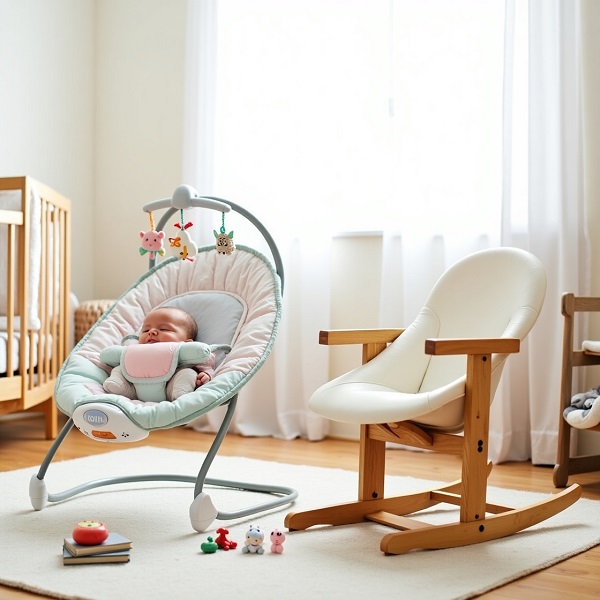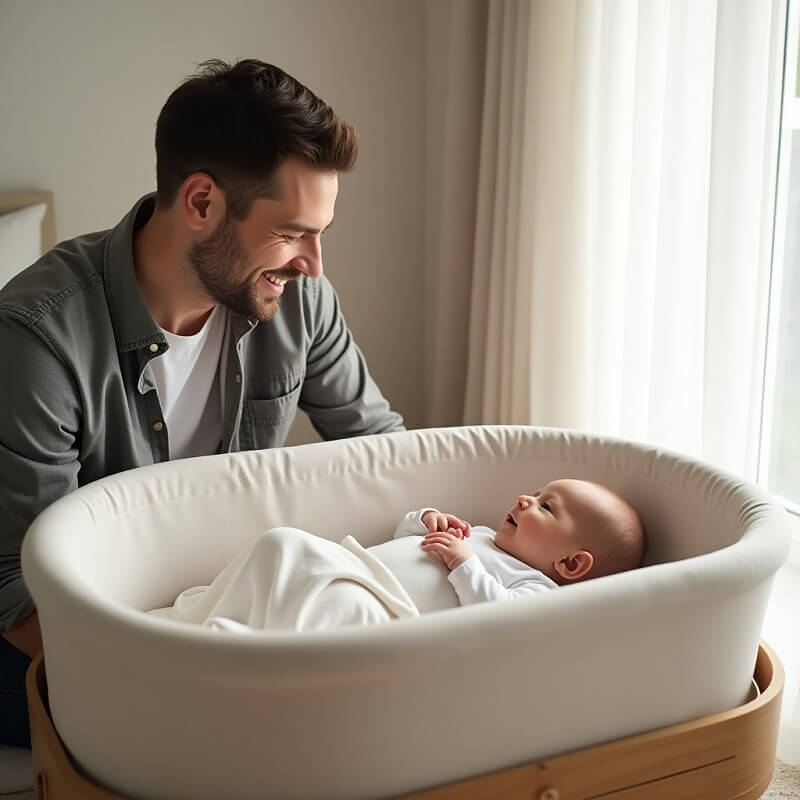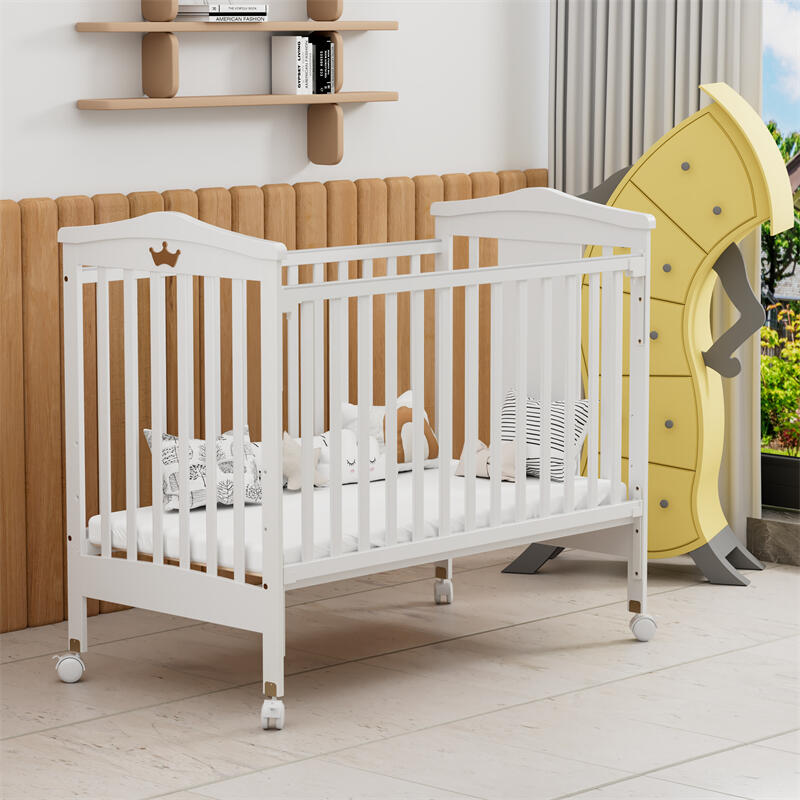Parenthood is a beautiful whirlwind—until your baby’s cries hit that I-need-to-be-held-right-now decibel level. Your arms ache, your coffee’s gone cold, and you’re desperately scanning the nursery for anything that might buy you five minutes of peace. Enter the baby bouncer and rocker, two of the most debated baby gear items among exhausted parents.
At first glance, they seem similar—both gently sway, both promise to calm your little one, and both claim to be “must-haves.” So, the question isn’t just “Should I get one?”—it’s “Which one will actually help me get through the day?”
Will one soothe a colicky newborn better than the other? Which is safer for longer rests? Can your baby outgrow it too soon? In this guide, we’ll unpack the subtle but significant differences between baby bouncers and rockers—not just from a product perspective, but from the lens of real parenting needs.
Baby Bouncer Vs Rocker: What’s the Difference?
At first glance, a baby bouncer and a rocker might seem like two versions of the same thing—soft, cozy little seats designed to give your arms a break while keeping your baby snug. And sure, they do look pretty similar. But once you dig a little deeper, the way they function—and how your baby interacts with them—starts to show some key differences.
A baby bouncer works off a simple but clever idea: built with a springy frame, the seat gently bounces in response to little kicks, stretches, or wiggling. That responsive motion can be super soothing for some babies, especially those who like to feel in control of what’s going on around them. The more they kick, the more the seat bounces—creating a kind of self-soothing rhythm that keeps them engaged and (hopefully) content for a little while.
Now, a baby rocker? Completely different vibe. This is the zen zone of baby gear. Instead of bouncing, it’s all about that smooth, swaying motion—the kind that mimics being rocked in your arms. Some rockers need a gentle nudge from you to get going, while others have a built-in glide that keeps the motion going. And that slightly reclined seat? Pure baby comfort. It’s essentially a snug little haven built for ultimate relaxation.
Some subtle developmental differences are also worth pointing out. Bouncers, by design, invite a bit more physical interaction. Babies who start to realize they can make the seat move by kicking often get a mini workout in the process. Rockers, in contrast, are more about passive comfort. Your baby can just relax and enjoy the ride—no effort required.
The table below breaks down the key differences between bouncers and rockers across some essential features:
| Feature | Baby Bouncer | Baby Rocker |
| Motion Type | Bouncing (up-and-down) | Rocking (back-and-forth) |
| Motion Source | Baby’s own movement or gentle caregiver tap | Caregiver-initiated or gravity-driven |
| Seat Position | Often upright with a slight recline | More reclined, cradle-like posture |
| Frame Design | Springy metal or flexible base | Curved or arched bottom for rocking |
| Use Case | Active playtime, engaging baby’s movement | Calm time, soothing or pre-nap routines |
| Portability | Lightweight and easy to move between rooms | Often bulkier, sometimes less convenient to relocate |
How Does Each One Soothe a Fussy Baby?
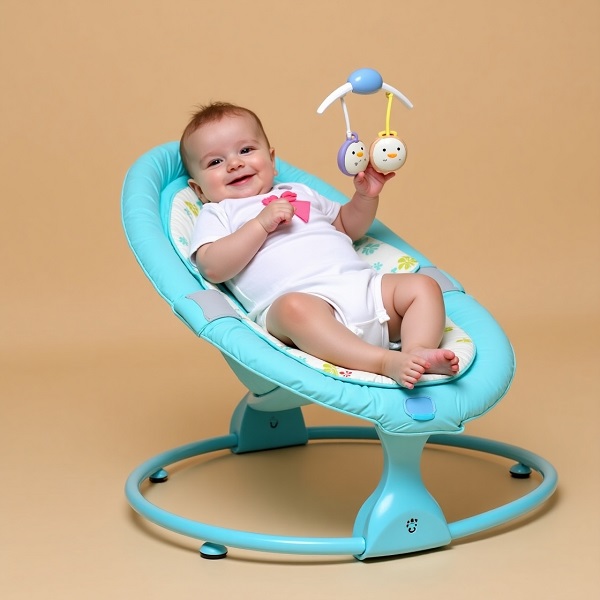
The Soothing Power of Baby Bouncers
Baby bouncers are all about baby-powered motion—your little one’s kicks, stretches, or even tiny hiccups make the seat bounce in response. That gentle rebound creates a natural rhythm that some babies find weirdly calming.
For fussy babies, it’s like a mini empowerment moment—they move, and the bouncer moves with them. That feedback (aka proprioception, aka knowing where their body is in space) can actually help some babies regulate their emotions.
For infants who are alert, active, or easily bored, that feedback loop can be reassuring and even entertaining, turning a frustrating moment into one of exploration and self-regulation.
The Calming Effect of Baby Rockers
Rockers operate on a different principle – what might be termed “passive soothing.” That gentle sway mimics the natural rocking motion we instinctively use when holding a baby.
The slow, rhythmic movement? It’s basically a hack for the parasympathetic nervous system (the one that says “chill out and digest”). Heart rate slows, breathing steadies, and those tiny tense muscles relax.
Because the movement doesn’t rely on your baby doing anything, rockers can be a real lifesaver when your little one is overtired or too upset to settle on their own. A lot of parents find they’re especially helpful during that late afternoon meltdown—or after a big, exciting outing.
Choosing the Right Soothing Approach
So which one’s better? Honestly, it depends on your baby and what kind of mood they’re in. Bouncers tend to be great for babies who like to be in motion and want to do something—especially if they get cranky from feeling confined.
Rockers, on the other hand, are often the go-to for babies who need help winding down. That steady rhythm helps break the cycle of crying and overstimulation. For many parents, a rocker becomes the secret weapon during those evening fuss sessions or for coaxing a little extra nap time.
Which Is Better for Your Newborn?
For fresh-out-the-womb newborns, rockers are the clear winner—they’re basically a womb replica! That gentle, rhythmic sway? Total déjà vu for your baby, mimicking the constant motion they felt for nine months. This makes rockers extra effective for:
Newborn sleep cycles – That smooth, rocking rhythm can help settle a fussy newborn and ease them into more regular sleep patterns. It taps into what’s known as the calming reflex—something newborns respond to instinctively.
Colic and digestion – Many rockers have a slight incline (when used correctly), which can be a big help for babies dealing with reflux or gas. The gentle motion also helps relax tight tummy muscles. Some pediatric occupational therapists even recommend rockers for colicky babies, since the movement stimulates the vagus nerve—a key player in digestion.
Bonding moments – Unlike bouncers, which encourage more solo interaction, rockers are perfect for quiet, face-to-face time. You can keep eye contact, talk softly, and gently rock your baby, which helps strengthen that early parent-baby bond during those alert windows.
While bouncers have their place, they present several limitations for newborns:
Underdeveloped muscle control – Newborns just don’t have the neck strength or coordination to get much out of a bouncer’s motion. They’re not quite ready to power it themselves.
Overstimulation risk – The bouncing motion and dangling toys that delight older infants can overwhelm newborns’ immature nervous systems. Newborns typically prefer the simpler, more contained environment of a rocker.
Positional concerns – Many bouncers hold babies in a semi-upright position, which isn’t ideal for newborn spine and hip development. Rockers tend to offer better full-body support, thanks to their more reclined design.
Which Is Safer for the Baby?
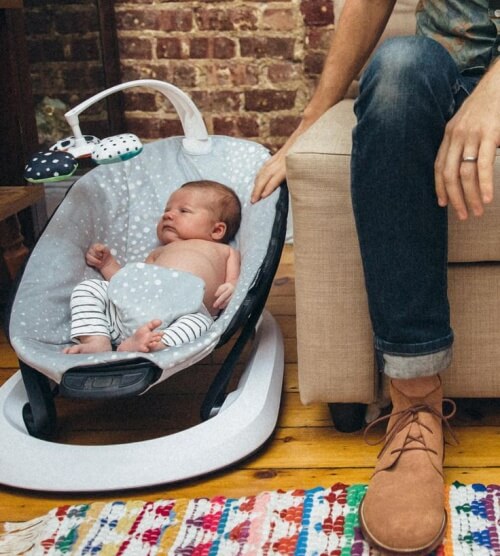
When comparing safety between baby bouncers and rockers, rockers generally emerge as the safer option for newborns and young infants.
That’s mostly thanks to their design. Most rockers offer a deeper recline, which gives better support for a baby’s head and neck. This kind of positioning helps lower the risk of positional asphyxia (when a baby’s airway gets blocked because of how they’re lying). Plus, rockers usually sit on a solid, stable base with a smooth glide, which makes them less prone to tipping than bouncers, which use a springy frame that can move more unpredictably.
That said, both bouncers and rockers can be safe—as long as they’re used correctly. No piece of baby gear is completely risk-free, and even the best-designed product can become unsafe if the basic safety guidelines are ignored.
Some rules apply no matter which one you’re using. Always place the device on the floor—never on a bed, sofa, countertop, or anything elevated. These surfaces increase the risk of falls, even with a baby who isn’t moving much yet. And always buckle your baby in, even if you’re just stepping away for a second.
Pediatric experts also suggest keeping use to short sessions—no more than 30 to 60 minutes at a time. This helps reduce the risk of breathing issues from staying in one position too long and encourages your baby to move, stretch, and explore outside of the seat.
No matter which option you go with, the safest setup always includes close supervision, following the recommended weight and age limits, and making sure your baby gets plenty of time on a flat surface to move freely.
How Long Can You Use Each?
One of the most practical questions parents ask before buying a baby bouncer or rocker is: How long will this actually last me? It’s a fair concern, after all, the lifespan of many baby products is surprisingly short.
In general, baby bouncers tend to stick around a little longer. If you go with a sturdy model that offers adjustable features, you might get several good months out of it. Most bouncers can be used until your baby starts trying to sit up on their own, roll over, or make escape attempts—usually somewhere between four and six months of age.
Rockers, especially the more cradled or deeply reclined ones, often have a shorter run. Since they’re designed more for soothing than for play, they’re ideal for those early months when your baby needs help settling down and isn’t quite mobile yet. After which, it gradually takes a back seat to more interactive or supportive gear like activity mats or infant seats with upright support.
Also worth noting: always check the weight limits and manufacturer guidelines. Most bouncers and rockers are rated up to a certain weight—usually around 20 to 25 pounds. Even if your baby still fits in the seat, going over that limit can make things wobbly or unsafe
Can Baby Sleep in a Bouncer or Rocker?
Many exhausted parents have been tempted to let their sleeping baby remain in a bouncer or rocker, especially when that gentle motion finally brings peace. However, pediatric experts overwhelmingly agree these devices should never be used for unsupervised sleep.
Unlike flat, firm crib mattresses that maintain open airways, the angled design can allow a baby’s head to fall forward, chin to chest. This position can silently restrict breathing because newborns lack the neck strength to readjust their heads. What’s especially scary? Babies in that position may not cry or move when their oxygen levels drop—so the warning signs are easy to miss.
There’s also the problem of soft padding. While those cushy fabrics feel great when your baby is awake, they can pose a suffocation risk during sleep. If a baby slumps sideways or turns their face into the padding, their tiny nose or mouth can get blocked.
So, what should you do if your baby nods off in a bouncer or rocker? First, stay close and keep an eye on their breathing. As soon as you can, gently move them to a safe sleep space—flat on their back, in a crib, bassinet, or play yard with no loose bedding or soft items.
If your baby seems to only fall asleep with motion, you’ve still got options. Gently rock your baby in your arms until they fall asleep, then place them in the crib.
Conclusion
After looking closely at both bouncers and rockers, one thing is clear—they’re each designed to meet different needs, and both can be incredibly helpful at the right time.
Rockers are often the better fit for those first few months. Their smooth, womb-like motion and supportive recline make them ideal for newborns who are still adjusting to life outside the belly. As your baby grows and becomes more active, that’s where bouncers really shine—giving them a safe, engaging space to kick, stretch, and start exploring how their little body works.
In the end, the best choice depends on your baby’s stage, temperament, and what helps them feel calm and content. Their needs will change quickly (as you’ll no doubt discover!), and your gear will need to adapt right along with them.
So let your baby’s cues lead the way, always put safety first, and don’t be afraid to phase things out once they’re no longer the right fit.
Recommended Related Articles:

